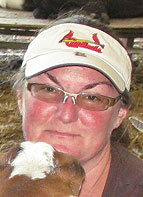
Lonnie Cook is a third generation farmer who continues his family’s tradition of raising Charolais and Charolais cross cattle on 640 acres once owned by his grandparents, Arthur and Mary Cook. Along with his brother, Derrel, who lives three miles up the Osage Fork River from Lonnie and his wife, Jean, they run 80-90 cows on his property.
Lonnie and Derrel grew up on that same farm in southeast Laclede County outside of Lebanon, Mo. which their parents, Bill and Lavern ran until Bill’s death in 1978. Lavern continued the operation with her sons’ help until 1985 when she moved to Lebanon. She recently celebrated her 90th birthday there. Lonnie and Derrel have found running the farm cooperatively has provided both with advantages as they worked other jobs.
“I was 30 years with Dairy Farmers of America in their plants in Cabool and Lebanon and my brother is a commercial plumber. He worked days and I did nights so that worked out real well.”
He continued, “My dad got his start in Charolais in the 1960s with Jerry Litton. He was THE Charolais dealer in the state at that time and might have actually brought his originally from France, I’m not sure. That’s how he and his family made it is this business and then of course, he went into politics after that. (Jerry Litton was running for the U.S. Senate in 1976 when he was killed in a small plane crash.) My dad was one of the first to have Charolais in this county back then. We also had 100 acres in corn at that time as we fed silage and ground corn. We didn’t grow any amount of hay back then and neither did anybody else around here. My brother and I had a basketball goal in the hay loft back then so of course, we didn’t want Dad taking up our basketball playing area with hay,” he laughed at the memory. “Our farm was always the gathering place when my brother and I were kids and it was the same with our children, now grown, daughters, Jina and Jill and son, Jason.”
Lonnie has seen many changes over the years but sticks to certain basics that experience has taught him are the keys to success in raising cattle. “I’ve never registered,” he added. “We do a cross with a Hereford bull and we keep an Angus bull for easy calving. Most years we’ve done three groups of cattle but this year, with the dry weather, we’ve just done two.
“You’ve got to watch the genetics and watch what you buy. To this day, if we get a cow with any fight, we sell them quick. When I buy a bull, I want one that looks at me just like a cow. You want to raise a calf on just grass, no feed, just some salt and minerals. Low input is important. You can get too much into them real quick. You don’t want to crowd your acreage and in a drought like now, I’m glad we’re not overstocked. That’s how you get through.”
Today, the Cooks have 100 acres of hay instead of corn. “We got away from the corn years ago when you could buy it about as cheap as you could raise it. We calve in mid-February for 90 days and when the calves are two months old, we treat them for blackleg, pink-eye and put in fly tags. Around the first of October, we castrate and de-horn and then put them back with their mommas for a little while to get them over the shock of being worked and then we wean them. After weaning, they are backgrounded to 700-800 pounds and sold as yearlings.”
He concluded, “Of course, I’ve cut back on fertilizer as it has gotten higher. Still use some, just not as much and I broadcast lots of clover seed each year. It’s the little things that will get you through the tough times.”







